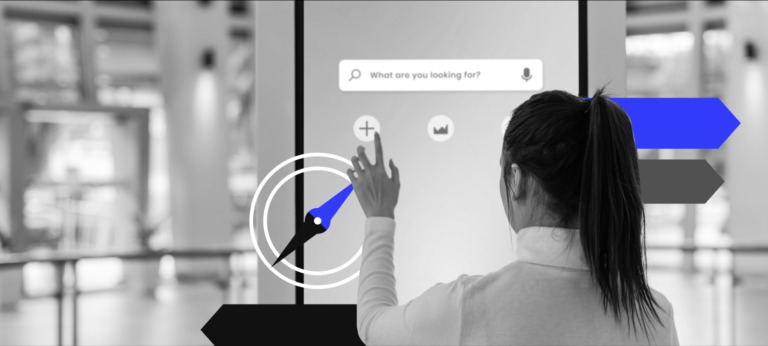In today’s fast-paced digital age, the importance of creating products that resonate with users at a global scale has never been more crucial for businesses of all scales. With the quicker adoption of technology and the ever-growing need for the same across industries, users are spending a lot more time interacting with digital mediums. To keep up with this requirement, products and services need to be not only functional but also fulfill user requirements intuitively, ensuring effective communication and interaction at every step of their product journey. And this is where human-centered design (HCD) comes into play.
Stuti Mazumdar & Vidhi Tiwarii - July 2024

By focusing on the needs, behaviors, and individual experiences of users, human-centered design ensures that products are not just solutions but meaningful experiences that are accessible to all. Let’s dive deep into what it is to closely look at how it impacts the real world.
What is a Human-Centered Approach to Design?
A human-centered design approach is a creative problem-solving approach that places the user at the center of the design process. Unlike traditional design methods, which often prioritize aesthetics or technical specifications depending on business objectives, human-centered design (HCD) prioritizes the needs, preferences, and constraints of the end users. It involves truly understanding the users, through keen observation, and then designing digital solutions that meet their specific needs.
The core principle of human-centered design (HCD) is simple: to design a product that people would love to use. To be able to achieve that, UX designers must first understand the target audience who will use it. This involves conducting thorough primary research, engaging with users directly through interviews and other research techniques, gathering insights from their experiences of using the product as well as competitor tools, and iteratively refining the product based on user feedback. By following this seemingly simple and fundamental framework, designers can create products that are not only usable but also highly desirable.
Defining the Framework of Human-Centered Design

The framework of human-centered design is designed as an approach to problem-solving, structured around several key stages. Each stage is crucial for ensuring that the final outcome (product) is aligned with the users’ needs and preferences.
1. Empathize
The Goal: Since the crux of the strategy is to humanize design, we begin by understanding the users’ needs, experiences, and emotions.
The Process: The team should conduct user interviews, observe users in their environment, and engage in immersive experiences to gain a deep understanding of their world.
The Deliverables: Out of the activities conducted, the team would generate empathy maps, personas, and user journey maps that capture the users’ perspectives and pain points.
2. Define
The Goal: The team of UI and UX designers, armed with the inferences made through user research, should clearly articulate the problem that needs to be solved.
The Process: Analyze the data collected during the empathize stage to identify patterns and insights. Define a clear problem statement that reflects the users’ needs.
The Deliverables: Through this exercise, you can attain a problem statement or point of view (POV) that guides the design process.
3. Ideate
The Goal: Post the research, the team can begin generating a wide range of ideas and solutions for products and services.
The Process: Conduct brainstorming sessions, sketch potential solutions, and use visionary techniques to explore various possibilities that can instill creativity within the team.
The Deliverables: You will, thus, get an expansive list of diverse ideas and concepts that can address the problem statement.
4. Prototype
The Goal: Filtering the first draft of ideas, the team will need to create tangible representations of ideas to explore their feasibility and usability.
The Process: Design low-fidelity prototypes, such as sketches, models, or interactive wireframes. Test these prototypes with users to gather feedback.
The Deliverables: The interactive, low–fidelity prototypes created can be iteratively refined based on user feedback.
5. Test
The Goal: It’s finally time to validate the prototypes and refine the solutions!
The Process: Conduct usability testing workshops with users to fully understand the impact of the design. Learn what works in your product and all the areas that require improvement in design elements, interaction, or content. Collect the feedback extensively to ensure no action item is missed out.
The Deliverables: The insights and feedback documented can be shared with the team and stakeholders to inform them of further refinements to the prototypes.
6. Implement
The Goal: Ultimately, the goal is to develop the final product and launch it to the market.
The Process: Work with development teams through their development process or lifecycle to build the product, ensuring that the design remains aligned with user needs. Conduct final rounds of testing and quality assurance.
The Deliverables: A finished product that is ready for release and addresses the users’ needs effectively.
What are the Guiding Principles of Human-Centered Design?

Much like every other aspect of design, human-centered design (HCD) also functions on 4 distinct guiding principles.
The first principle is to be people-focused. It emphasizes the importance of placing users at the heart of the design process. It involves deeply understanding the users’ needs, behaviors, and pain points through direct engagement methods such as interviews, observations, and surveys. By developing empathy and a genuine connection with the users, designers can create products and services that resonate on a personal level, enhancing user satisfaction and loyalty. A people-focused approach ensures that the design process is not driven by assumptions or preconceived notions but by real insights derived from the users’ experiences. This principle underscores the essence of HCD: designing for people, with people in mind.
The second principle is identifying and tackling the right problem. It is critical for the success of any design endeavor. Often, UX designers may be tempted to address symptoms rather than the root causes of issues owing to personal biases. This principle advocates for a thorough problem-stating process, where designers invest time in understanding the context and underlying factors contributing to the problem. By defining a clear and accurate problem statement, designers can channel their efforts toward developing solutions that effectively address the core issues. This focused approach not only saves time and resources but also ensures that the final product provides real value to the users.
The third principle, iterate and experiment, highlights the importance of an iterative design process. Much like the ever-evolving challenges in our lives, the process emphasizes the need for evolving experimentation of design solutions to ensure we continue to solve user problems. Rather than striving for a perfect solution from the outset, HCD encourages a cycle of prototyping, testing, and refining. This principle supports a mindset of continuous learning and improvement, where each iteration brings designers closer to an optimal solution. Experimentation allows for the exploration of multiple ideas and approaches, fostering creativity and innovation.
The fourth principle is to consider everything as a system. It advocates for a holistic perspective in the design process. Products and services do not exist in isolation; they are part of broader ecosystems that include users, environments, technologies, and social contexts—it’s all part of a big picture that designers ought to see. Thus, this principle emphasizes the importance of understanding how different components interact and influence each other within the system. By considering these interconnections, designers can anticipate potential challenges and opportunities, creating solutions that are not only user-friendly but also sustainable and adaptable. A systems-thinking approach ensures that the design is resilient and can evolve with changing user needs and environmental conditions.
The Importance of Human-Centered Design Approach

The human-centered design (HCD) approach is vital for multiple reasons, significantly impacting product development, user satisfaction, and overall market success. The sheer impact of it is the reason that it continues to be adopted by various large-scale organizations and enterprises globally. Let’s take a look at a few that we must consistently consider and advocate for.
1. Enhances User Experience
At its core, HCD prioritizes the needs and experiences of users, leading to enhanced user experience. By focusing on the users’ needs and preferences, HCD ensures that the product is intuitive and easy to use. This leads to higher user satisfaction and engagement.
2. Increases Market Success
It is a given, when the consumers’ satisfaction scale tips to a positive, so does the market success for the product.
Products designed with a human-centered approach are more likely to succeed in the market. By addressing real user problems, these products can attract and retain more customers.
3. Fosters Innovation
The iterative nature of HCD encourages experimentation and continuous improvement. After all, it is one of the principles of the human-centered design approach.
By iterating on prototypes and gathering feedback, designers can explore a wide range of ideas and solutions. This process not only helps refine the product but also fosters creativity and innovation. By constantly seeking user feedback and making adjustments, designers can uncover novel solutions that might not have been apparent initially. This culture of experimentation and iteration ensures that the final product is not only effective but also innovative and unique.
4. Reduces Risk
HCD reduces the risk of product failure by involving users early and often in the design process. By engaging with users at the onset of a sprint, designers can identify potential issues and misunderstandings before they become costly problems. Early testing and feedback help uncover usability issues, design flaws, and other potential obstacles, allowing designers to address them before the product is fully developed. This proactive approach minimizes the risk of launching a product that fails to meet user expectations or market demands. As a result, companies can save time, resources, and money by preventing costly redesigns and modifications later in the development process.
Additionally, this approach to problem-solving aids in frequent and timely checkpoints in the sprint, giving the team ample time for troubleshooting their design framework.
5. Builds Brand Loyalty
When users feel that a product has been designed with their needs in mind, they are more likely to develop a strong emotional connection with it. This emotional bond fosters brand loyalty, as users are more inclined to stick with a brand that consistently delivers positive experiences. They advocate for the brand on your behalf, promoting the product to others and contributing to word-of-mouth marketing.




